Titanite Textures, U-Pb Dating, Chemistry, and In Situ Nd Isotopes of the Lalingzaohuo Mafic Magmatic Enclaves and Host Granodiorites in the East Kunlun Orogen Belt: Insights into Magma Mixing Processes
Abstract
1. Introduction
2. Geological Background
3. Petrography
4. Analytical Methods
4.1. Whole-Rock Major and Trace Element Analyses
4.2. Major Oxide Compositions Analyses and Elemental Intensity X-Ray Mapping
4.3. U–Pb Dating and Trace Element Analyses for Titanite
4.4. In Situ Sm-Nd Isotopic Analysis for Titanite
5. Results
5.1. Texture of Titanite
5.2. Whole-Rock Major and Trace Elemental Compositions
5.3. Titanite U–Pb Ages
5.4. Major and Trace Element Compositions of Titanite
5.5. In Situ Nd Isotopic Compositions of Titanite
6. Discussion
6.1. Origin of the MMEs
6.2. Magma Mixing Processes Recorded in Titanite
7. Conclusions
Supplementary Materials
Author Contributions
Funding
Data Availability Statement
Acknowledgments
Conflicts of Interest
References
- Didier, J. Granites and Their Enclaves; Elsevier: Amsterdam, The Netherlands, 1973. [Google Scholar]
- Bacon, C.R. Magmatic Inclusions in Silicic and Intermediate Volcanic Rocks. J. Geophys. Res. Solid Earth 1986, 91, 6091–6112. [Google Scholar] [CrossRef]
- Clemens, J.D. S-Type Granitic Magmas—Petrogenetic Issues, Models and Evidence. Earth Sci. Rev. 2003, 61, 1–18. [Google Scholar] [CrossRef]
- Clemens, J.D.; Elburg, M.A.; Harris, C. Origins of Igneous Microgranular Enclaves in Granites: The Example of Central Victoria, Australia. Contrib. Mineral. Petrol. 2017, 172, 88. [Google Scholar] [CrossRef]
- Sparks, S.R.J.; Sigurdsson, H.; Wilson, L. Magma Mixing: A Mechanism for Triggering Acid Explosive Eruptions. Nature 1977, 267, 315–318. [Google Scholar] [CrossRef]
- Eichelberger, J.C. Andesitic Volcanism and Crustal Evolution. Nature 1978, 275, 21–27. [Google Scholar] [CrossRef]
- Vernon, R.H. Microgranitoid Enclaves in Granites—Globules of Hybrid Magma Quenched in a Plutonic Environment. Nature 1984, 309, 438–439. [Google Scholar] [CrossRef]
- Yang, J.H.; Wu, F.Y.; Chung, S.L.; Wilde, S.A.; Chu, M.F. Multiple Sources for the Origin of Granites: Geochemical and Nd/Sr Isotopic Evidence from the Gudaoling Granite and Its Mafic Enclaves, Northeast China. Geochim. Cosmochim. Acta 2004, 68, 4469–4483. [Google Scholar] [CrossRef]
- Weinberg, R.F.; Vernon, R.H.; Schmeling, H. Processes in Mushes and Their Role in the Differentiation of Granitic Rocks. Earth Sci. Rev. 2021, 220, 103665. [Google Scholar] [CrossRef]
- Irvine, T.N.; Andersen, J.C.Ø.; Brooks, C.K. Included Blocks (and Blocks within Blocks) in the Skaergaard Intrusion: Geologic Relations and the Origins of Rhythmic Modally Graded Layers. Bull. Geol. Soc. Am. 1998, 110, 1398–1447. [Google Scholar] [CrossRef]
- Baxter, S.; Feely, M. Magma Mixing and Mingling Textures in Granitoids: Examples from the Galway Granite, Connemara, Ireland. Mineral. Petrol. 2002, 76, 63–74. [Google Scholar] [CrossRef]
- Barbarin, B. Mafic Magmatic Enclaves and Mafic Rocks Associated with Some Granitoids of the Central Sierra Nevada Batholith, California: Nature, Origin, and Relations with the Hosts. Lithos 2005, 80, 155–177. [Google Scholar] [CrossRef]
- Flinders, J.; Clemens, J.D. Non-Linear Dynamics, Chaos, Complexity and Enclaves in Granitoid Magmas. Earth Environ. Sci. Trans. R. Soc. Edinb. 1996, 87, 217–223. [Google Scholar] [CrossRef]
- Lesher, C.E. Decoupling of Chemical and Isotopic Exchange during Magma Mixing. Nature 1990, 344, 235–237. [Google Scholar] [CrossRef]
- Griffin, W.L.; Wang, X.; Jackson, S.E.; Pearson, N.J.; O’Reilly, S.Y.; Xu, X.; Zhou, X. Zircon Chemistry and Magma Mixing, SE China: In-Situ Analysis of Hf Isotopes, Tonglu and Pingtan Igneous Complexes. Lithos 2002, 61, 237–269. [Google Scholar] [CrossRef]
- Davidson, J.P.; Morgan, D.J.; Charlier, B.L.A. Isotopic Microsampling of Magmatic Rocks. Elements 2007, 3, 253–259. [Google Scholar] [CrossRef]
- Bruand, E.; Storey, C.; Fowler, M. Accessory Mineral Chemistry of High Ba-Sr Granites from Northern Scotland: Constraints on Petrogenesis and Records of Whole-Rock Signature. J. Petrol. 2014, 55, 1619–1651. [Google Scholar] [CrossRef]
- Mcleod, G.W.; Dempster, T.J.; Faithfull, J.W. Deciphering Magma-Mixing Processes Using Zonedtitanite from the Ross of Mull Granite, Scotland. J. Petrol. 2011, 52, 55–82. [Google Scholar] [CrossRef]
- Jiang, P.; Yang, K.F.; Fan, H.R.; Liu, X.; Cai, Y.C.; Yang, Y.H. Titanite-Scale Insights into Multi-Stage Magma Mixing in Early Cretaceous of NW Jiaodong Terrane, North China Craton. Lithos 2016, 258–259, 197–214. [Google Scholar] [CrossRef]
- Hu, H.; Li, J.-W.; McFarlane, C.R.M.; Luo, Y.; McCarron, T. Textures, Trace Element Compositions, and U–Pb Ages of Titanite from the Mangling Granitoid Pluton, East Qinling Orogen: Implications for Magma Mixing and Destruction of the North China Craton. Lithos 2017, 284, 50–68. [Google Scholar] [CrossRef]
- Gao, X.-Y.; Zheng, Y.-F.; Chen, Y.-X.; Guo, J. Geochemical and U–Pb Age Constraints on the Occurrence of Polygenetic Titanites in UHP Metagranite in the Dabie Orogen. Lithos 2012, 136–139, 93–108. [Google Scholar] [CrossRef]
- Chen, Y.X.; Zheng, Y.F.; Hu, Z. Polyphase Growth of Accessory Minerals during Continental Collision: Geochemical Evidence from Ultrahigh-Pressure Metamorphic Gneisses in the Sulu Orogen. Lithos 2013, 177, 245–267. [Google Scholar] [CrossRef]
- Chen, Y.X.; Zheng, Y.F. Extreme Nb/Ta Fractionation in Metamorphic Titanite from Ultrahigh-Pressure Metagranite. Geochim. Cosmochim. Acta 2015, 150, 53–73. [Google Scholar] [CrossRef]
- Li, J.W.; Deng, X.D.; Zhou, M.F.; Liu, Y.S.; Zhao, X.F.; Guo, J.L. Laser Ablation ICP-MS Titanite U-Th-Pb Dating of Hydrothermal Ore Deposits: A Case Study of the Tonglushan Cu-Fe-Au Skarn Deposit, SE Hubei Province, China. Chem. Geol. 2010, 270, 56–67. [Google Scholar] [CrossRef]
- Xie, L.; Wang, R.-C.; Chen, J.; Zhu, J.-C. Mineralogical Evidence for Magmatic and Hydrothermal Processes in the Qitianling Oxidized Tin-Bearing Granite (Hunan, South China): EMP and (MC)-LA-ICPMS Investigations of Three Types of Titanite. Chem. Geol. 2010, 276, 53–68. [Google Scholar] [CrossRef]
- Cao, M.J.; Qin, K.Z.; Li, G.M.; Evans, N.J.; Jin, L.Y. In Situ LA-(MC)-ICP-MS Trace Element and Nd Isotopic Compositions and Genesis of Polygenetic Titanite from the Baogutu Reduced Porphyry Cu Deposit, Western Junggar, NW China. Ore Geol. Rev. 2015, 65, 940–954. [Google Scholar] [CrossRef]
- Pan, L.C.; Hu, R.Z.; Bi, X.W.; Li, C.; Wang, X.S.; Zhu, J.J. Titanite Major and Trace Element Compositions as Petrogenetic and Metallogenic Indicators of Mo Ore Deposits: Examples from Four Granite Plutons in the Southern Yidun Arc, SW China. Am. Mineral. 2018, 103, 1417–1434. [Google Scholar] [CrossRef]
- Clark, A.M. A Tantalum-Rich Variety of Sphene. Mineral. Mag. 1974, 39, 605–607. [Google Scholar] [CrossRef]
- Higgins, J.B.; Ribbe, P.H. The Crystal Chemistry and Space Groups of Natural and Synthetic Titanites. Am. Mineral. 1976, 61, 878–888. [Google Scholar]
- Franz, G.; Spear, F.S. Aluminous Titanite (Sphene) from the Eclogite Zone, South-Central Tauern Window, Austria. Chem. Geol. 1985, 50, 33–46. [Google Scholar] [CrossRef]
- Wones, D.R. Significance of the Assemblage Titanite + Magnetite + Quartz in Granitic Rocks. Am. Mineral. 1989, 74, 744–749. [Google Scholar]
- Paterson, B.A.; Stephens, W.E. Kinetically Induced Compositional Zoning in Titanite: Implications for Accessory-Phase/Melt Partitioning of Trace Elements. Contrib. Mineral. Petrol. 1992, 109, 373–385. [Google Scholar] [CrossRef]
- Frost, B.R.; Chamberlain, K.R.; Schumacher, J.C. Sphene (Titanite): Phase Relations and Role as a Geochronometer. Chem. Geol. 2000, 172, 131–148. [Google Scholar] [CrossRef]
- Piccoli, P.; Candela, P.; Rivers, M. Interpreting Magmatic Processes from Accessory Phases: Titanite—a Small Recorder of Large-Scale Processes. Trans. R. Soc. Edinb. Earth Sci. 2000, 91, 257–267. [Google Scholar] [CrossRef]
- Tiepolo, M.; Oberti, R.; Vannucci, R. Trace-Element Incorporation in Titanite: Constraints from Experimentally Determined Solid/Liquid Partition Coefficients. Chem. Geol. 2002, 191, 105–119. [Google Scholar] [CrossRef]
- Cherniak, D.J. Nb and Ta Diffusion in Titanite. Chem. Geol. 2015, 413, 44–50. [Google Scholar] [CrossRef]
- Green, T.H.; Pearson, N.J. Rare-Earth Element Partitioning between Sphene and Coexisting Silicate Liquid at High Pressure and Temperature. Chem. Geol. 1986, 55, 105–119. [Google Scholar] [CrossRef]
- Olierook, H.K.H.; Taylor, R.J.M.; Erickson, T.M.; Clark, C.; Reddy, S.M.; Kirkland, C.L.; Jahn, I.; Barham, M. Unravelling Complex Geologic Histories Using U–Pb and Trace Element Systematics of Titanite. Chem. Geol. 2019, 504, 105–122. [Google Scholar] [CrossRef]
- Depaolo, D.J. Neodymium Isotopes in the Colorado Front Range and Crust-Mantle Evolution in the Proterozoic. Nature 1981, 291, 193–196. [Google Scholar] [CrossRef]
- Hayden, L.A.; Watson, E.B.; Wark, D.A. A Thermobarometer for Sphene (Titanite). Contrib. Mineral. Petrol. 2008, 155, 529–540. [Google Scholar] [CrossRef]
- Aleksandrov, S.M.; Troneva, M.A. Composition, Mineral Assemblages, and Genesis of Titanite and Malayaite in Skarns. Geochem. Int. 2007, 45, 1012–1024. [Google Scholar] [CrossRef]
- Smith, M.P.; Storey, C.D.; Jeffries, T.E.; Ryan, C. In Situ U-Pb and Trace Element Analysis of Accessory Minerals in the Kiruna District, Norrbotten, Sweden: New Constraints on the Timing and Origin of Mineralization. J. Petrol. 2009, 50, 2063–2094. [Google Scholar] [CrossRef]
- Xiong, F.H.; Ma, C.Q.; Zhang, J.Y.; Liu, B. The Origin of Mafic Microgranular Enclaves and Their Host Granodiorites from East Kunlun, Northern Qinghai-Tibet Plateau: Implications for Magma Mixing during Subduction of Paleo-Tethyan Lithosphere. Mineral. Petrol. 2012, 104, 211–224. [Google Scholar] [CrossRef]
- Mo, X.; Luo, Z.; Deng, J.; Liu, C.; Chen, H.; Yuan, W.; Liu, Y. Granitoids and Crustal Growth in the East-Kunlun Orogenic Belt. Geol. J. China Univ. 2007, 13, 403–414, (In Chinese with English abstract). [Google Scholar]
- Dong, Y.; Sun, S.; Liu, X.; He, D.; Zhou, X.; Zhang, F.; Yang, Z.; Zhou, D. Geochronology and Geochemistry of the Yazidaban Ophiolitic Mélange in Qimantagh: Constraints on the Early Paleozoic Back-Arc Basin of the East Kunlun Orogen, Northern Tibetan Plateau. J. Geol. Soc. Lond. 2019, 176, 306–322. [Google Scholar] [CrossRef]
- Shao, F.; Niu, Y.; Liu, Y.; Chen, S.; Kong, J.; Duan, M. Petrogenesis of Triassic Granitoids in the East Kunlun Orogenic Belt, Northern Tibetan Plateau and Their Tectonic Implications. Lithos 2017, 282–283, 33–44. [Google Scholar] [CrossRef]
- Chen, J.; Li, B.; Zhou, J.X. Origin and Tectonic Setting of Middle–Late Triassic Lalingzaohuo Granitoids in the Western East Kunlun Orogen, Northern Tibetan Plateau. Int. Geol. Rev. 2024, 66, 2581–2597. [Google Scholar] [CrossRef]
- Huang, H.; Niu, Y.; Nowell, G.; Zhao, Z.; Yu, X.; Zhu, D.C.; Mo, X.; Ding, S. Geochemical Constraints on the Petrogenesis of Granitoids in the East Kunlun Orogenic Belt, Northern Tibetan Plateau: Implications for Continental Crust Growth through Syn-Collisional Felsic Magmatism. Chem. Geol. 2014, 370, 1–18. [Google Scholar] [CrossRef]
- Gong, S.; Chen, N.; Wang, Q.; Kusky, T.M.; Wang, L.; Zhang, L.; Ba, J.; Liao, F. Early Paleoproterozoic Magmatism in the Quanji Massif, Northeastern Margin of the Qinghai-Tibet Plateau and Its Tectonic Significance: LA-ICPMS U-Pb Zircon Geochronology and Geochemistry. Gondwana Res. 2012, 21, 152–166. [Google Scholar] [CrossRef]
- Xiong, F.; Yan, D.; Ma, C.; Hou, M.; Wang, M.; Huang, H.; Wang, W. Geochemical and Petrological Diversity of a Transcrustal Magmatic System Driven by Mushy Magma Mixing: Insights from the Triassic Dike Swarms in East Kunlun Orogen, Northern Tibetan Plateau. Geol. Soc. Am. Bull. 2024, 136, 5058–5074. [Google Scholar] [CrossRef]
- Bi, H.; Whitney, D.L.; Song, S.; Zhou, X. HP–UHP Eclogites in the East Kunlun Orogen, China: P–T Evidence for Asymmetric Suturing of the Proto-Tethys Ocean. Gondwana Res. 2022, 104, 199–214. [Google Scholar] [CrossRef]
- Paton, C.; Hellstrom, J.; Paul, B.; Woodhead, J.; Hergt, J. Iolite: Freeware for the Visualisation and Processing of Mass Spectrometric Data. J. Anal. At. Spectrom. 2011, 26, 2508–2518. [Google Scholar] [CrossRef]
- Tera, F.; Wasserburg, G.J. U-Th-Pb Systematics in Three Apollo 14 Basalts and the Problem of Initial Pb in Lunar Rocks. Earth Planet. Sci. Lett. 1972, 14, 281–304. [Google Scholar] [CrossRef]
- Ludwig, K.R. User’s Manual for Isoplot 3.75: A Geochronological Toolkit for Microsoft Excel. Berkeley Geochronol. Cent. Spec. Publ. 2012, 5, 75. [Google Scholar]
- Spandler, C.; Hammerli, J.; Sha, P.; Hilbert-Wolf, H.; Hu, Y.; Roberts, E.; Schmitz, M. MKED1: A New Titanite Standard for in Situ Analysis of Sm-Nd Isotopes and U-Pb Geochronology. Chem. Geol. 2016, 425, 110–126. [Google Scholar] [CrossRef]
- Ma, Q.; Evans, N.J.; Ling, X.X.; Yang, J.H.; Wu, F.Y.; Zhao, Z.D.; Yang, Y.H. Natural Titanite Reference Materials for In Situ U-Pb and Sm-Nd Isotopic Measurements by LA-(MC)-ICP-MS. Geostand. Geoanalytical Res. 2019, 43, 355–384. [Google Scholar] [CrossRef]
- Sun, S.S.; McDonough, W.F. Chemical and Isotopic Systematics of Oceanic Basalts: Implications for Mantle Composition and Processes. Geol. Soc. Spec. Publ. 1989, 42, 313–345. [Google Scholar] [CrossRef]
- Defant, M.J.; Drummond, M.S. Derivation of Some Modern Arc Magmas by Melting of Young Subducted Lithosphere. Nature 1990, 347, 662–665. [Google Scholar] [CrossRef]
- Förster, H.J.; Tischendorf, G.; Trumbull, R.B. An Evaluation of the Rb vs. (Y + Nb) Discrimination Diagram to Infer Tectonic Setting of Silicic Igneous Rocks. Lithos 1997, 40, 261–293. [Google Scholar] [CrossRef]
- Hibbard, M.J. The Magma Mixing Origin of Mantled Feldspars. Contrib. Mineral. Petrol. 1981, 76, 158–170. [Google Scholar] [CrossRef]
- Tsuchiyama, A.; Takahashi, E. Melting Kinetics of a Plagioclase Feldspar. Contrib. Mineral. Petrol. 1983, 84, 345–354. [Google Scholar] [CrossRef]
- Humphreys, M.C.S.; Blundy, J.D.; Sparks, R.S.J. Magma Evolution and Open-System Processes at Shiveluch Volcano: Insights from Phenocryst Zoning. J. Petrol. 2006, 47, 2303–2334. [Google Scholar] [CrossRef]
- Zhao, Z.; Wang, C.Y.; Dou, J.; Wei, B. A Mush-Facilitated Magma Mixing Process Revealed by Complex Zoning of Plagioclase in Mafic Magmatic Enclaves of the Early Cretaceous Sanguliu Granitic Pluton, East China. J. Petrol. 2023, 64, egad048. [Google Scholar] [CrossRef]
- Nelson, S.T.; Montana, A. Sieve-Textured Plagioclase in Volcanic Rocks Produced by Rapid Decompression. Am. Mineral. 1992, 77, 1242–1249. [Google Scholar]
- Pietranik, A.; Waight, T.E. Processes and Sources during Late Variscan Dioritic-Tonalitic Magmatism: Insights from Plagioclase Chemistry (Gesiniec Intrusion, NE Bohemian Massif, Poland). J. Petrol. 2008, 49, 1619–1645. [Google Scholar] [CrossRef]
- Renjith, M.L.; Charan, S.N.; Subbarao, D.V.; Babu, E.V.S.S.K.; Rajashekhar, V.B. Grain to Outcrop-Scale Frozen Moments of Dynamic Magma Mixing in the Syenite Magma Chamber, Yelagiri Alkaline Complex, South India. Geosci. Front. 2014, 5, 801–820. [Google Scholar] [CrossRef]
- Putirka, K. Amphibole Thermometers and Barometers for Igneous Systems and Some Implications for Eruption Mechanisms of Felsic Magmas at Arc Volcanoes. Am. Mineral. 2016, 101, 841–858. [Google Scholar] [CrossRef]
- Mutch, E.J.F.; Blundy, J.D.; Tattitch, B.C.; Cooper, F.J.; Brooker, R.A. An Experimental Study of Amphibole Stability in Low-Pressure Granitic Magmas and a Revised Al-in-Hornblende Geobarometer. Contrib. Mineral. Petrol. 2016, 171, 85. [Google Scholar] [CrossRef]
- Plail, M.; Edmonds, M.; Woods, A.W.; Barclay, J.; Humphreys, M.C.S.; Herd, R.A.; Christopher, T. Mafic Enclaves Record Syn-Eruptive Basalt Intrusion and Mixing. Earth Planet. Sci. Lett. 2018, 484, 30–40. [Google Scholar] [CrossRef]
- Watson, E.B.; Liang, Y. A Simple Model for Sector Zoning in Slowly Grown Crystals: Implications for Growth Rate and Lattice Diffusion, with Emphasis on Accessory Minerals in Crustal Rocks. Am. Mineral. 1995, 80, 1179–1187. [Google Scholar] [CrossRef]
- Zhao, Z.; Wang, C.Y.; Wei, B.; Dou, J. Elemental and Nd Isotopic Compositions of Zoned Titanite in Mafic Microgranular Enclaves of the Early Cretaceous Sanguliu Granitic Pluton in the North China Craton: Insights into Magma Mixing Process. Lithos 2021, 392–393, 106138. [Google Scholar] [CrossRef]
- Johannes, W.; Holtz, F. Formation of Granitic Magmas by Dehydration Melting. In Petrogenesis and Experimental Petrology of Granitic Rocks; Springer: Berlin/Heidelberg, Germany, 1996; pp. 264–301. [Google Scholar]
- Shannon, R.D. Revised Effective Ionic Radii and Systematic Studies of Interatomic Distances in Halides and Chalcogenides. Acta Crystallogr. Sect. A 1976, 32, 751–767. [Google Scholar] [CrossRef]
- Sun, J.F.; Yang, J.H.; Wu, F.Y.; Li, X.H.; Yang, Y.H.; Xie, L.W.; Wilde, S.A. Magma Mixing Controlling the Origin of the Early Cretaceous Fangshan Granitic Pluton, North China Craton: In Situ U-Pb Age and Sr-, Nd-, Hf- and O-Isotope Evidence. Lithos 2010, 120, 421–438. [Google Scholar] [CrossRef]
- Fu, Y.; Sun, X.M.; Zhou, H.Y.; Lin, H.; Yang, T.J. In-Situ LA-ICP-MS U-Pb Geochronology and Trace Elements Analysis of Polygenetic Titanite from the Giant Beiya Gold-Polymetallic Deposit in Yunnan Province, Southwest China. Ore Geol. Rev. 2016, 77, 43–56. [Google Scholar] [CrossRef]
- Prowatke, S.; Klemme, S. Effect of Melt Composition on the Partitioning of Trace Elements between Titanite and Silicate Melt. Geochim. Cosmochim. Acta 2005, 69, 695–709. [Google Scholar] [CrossRef]
- Kontonikas-Charos, A.; Ehrig, K.; Cook, N.J.; Ciobanu, C.L. Crystal Chemistry of Titanite from the Roxby Downs Granite, South Australia: Insights into Petrogenesis, Subsolidus Evolution and Hydrothermal Alteration. Contrib. Mineral. Petrol. 2019, 174, 59. [Google Scholar] [CrossRef]
- Williams, R.W.; Gill, J.B. Effects of Partial Melting on the Uranium Decay Series. Geochim. Cosmochim. Acta 1989, 53, 1607–1619. [Google Scholar] [CrossRef]

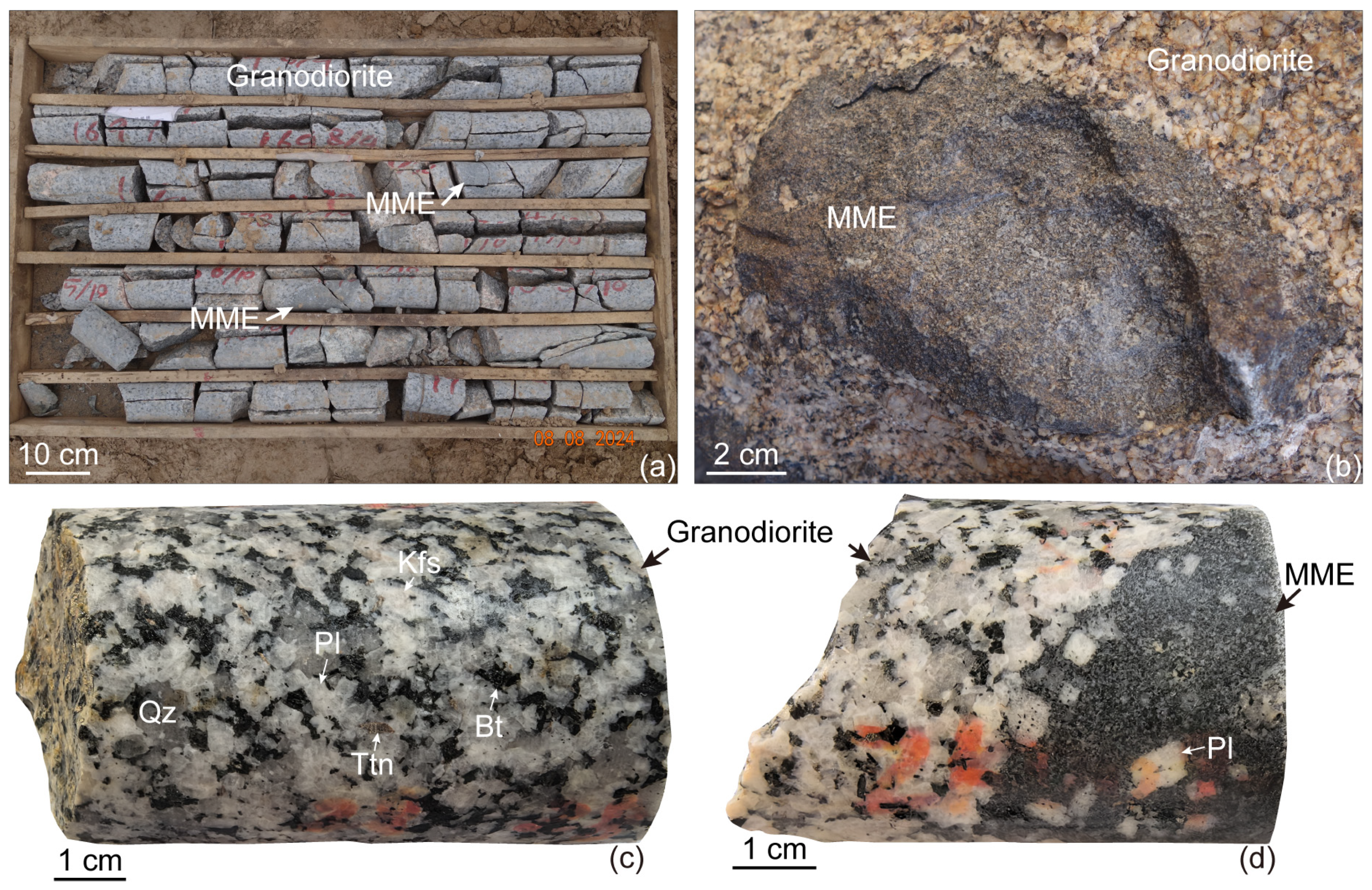

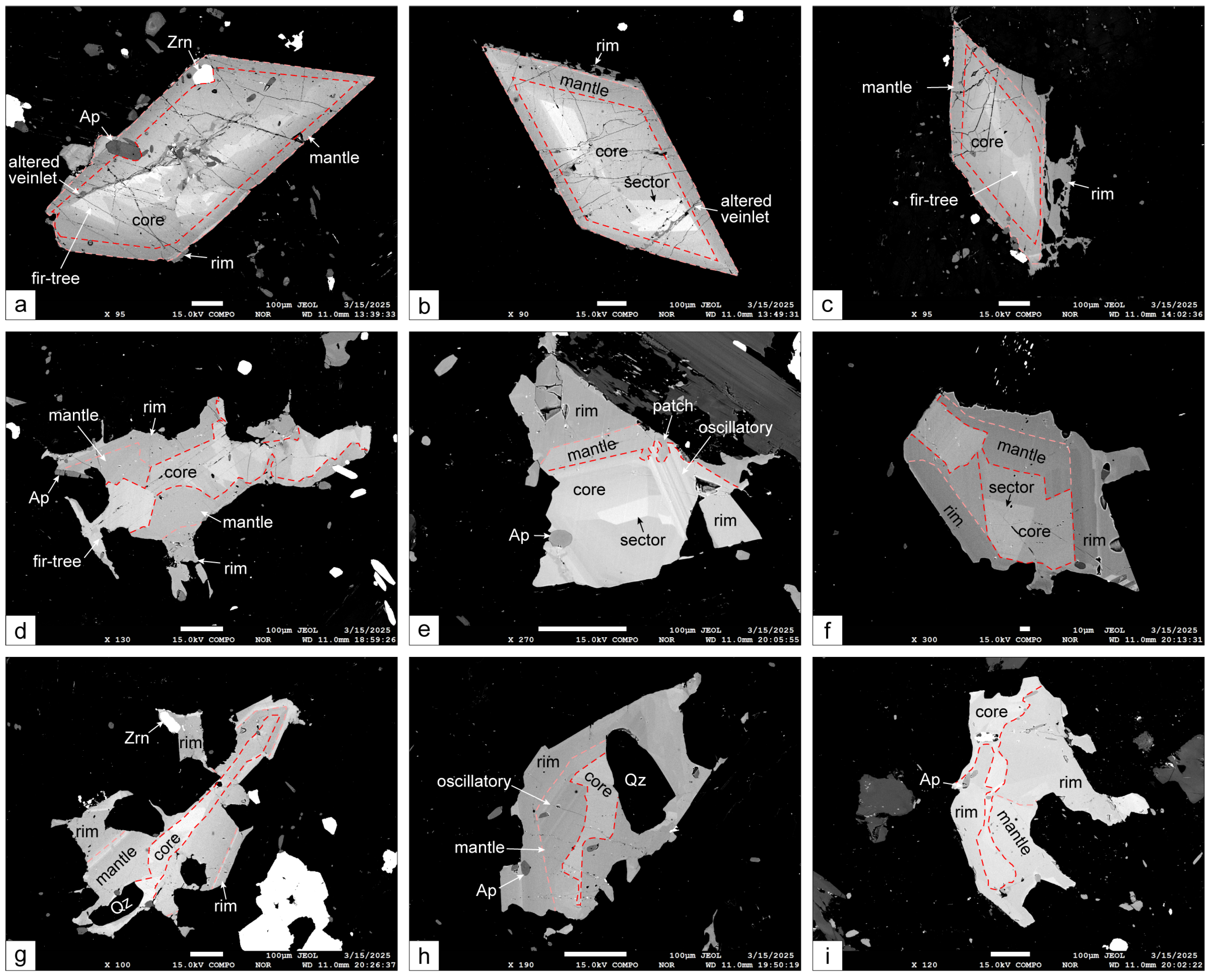

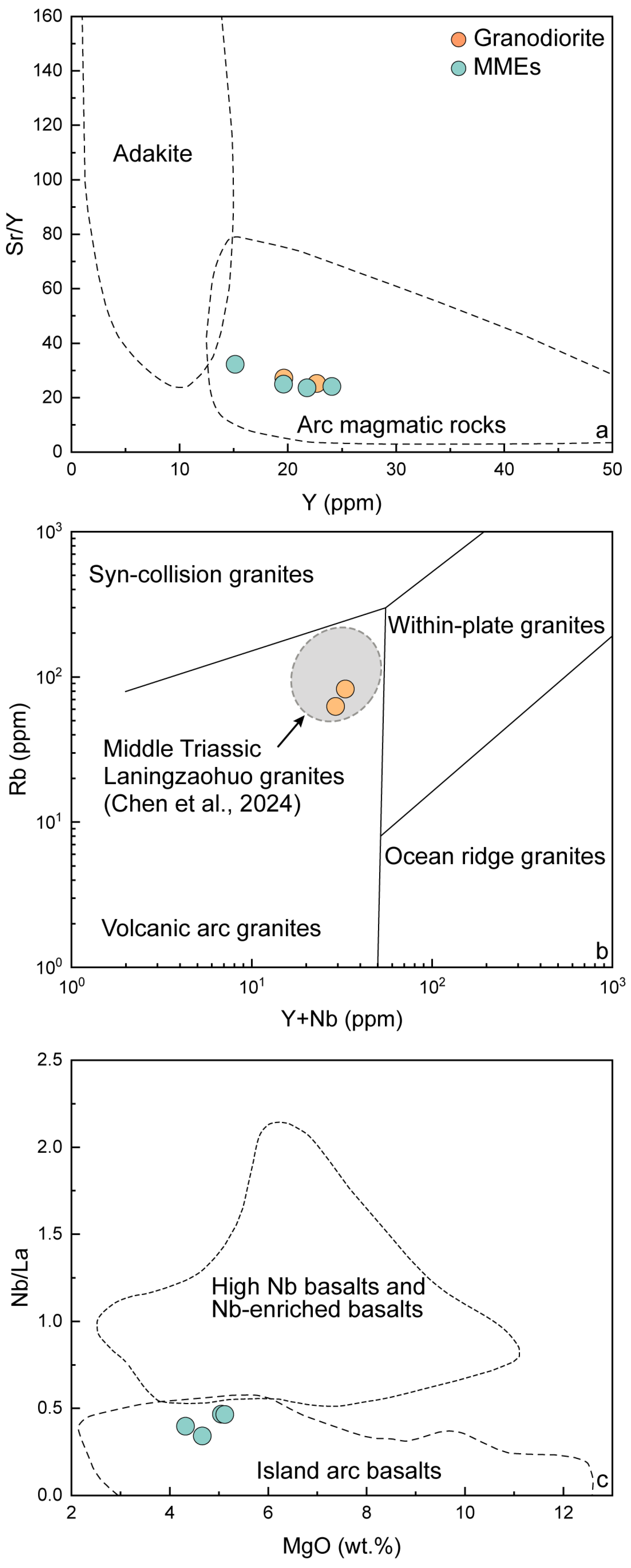
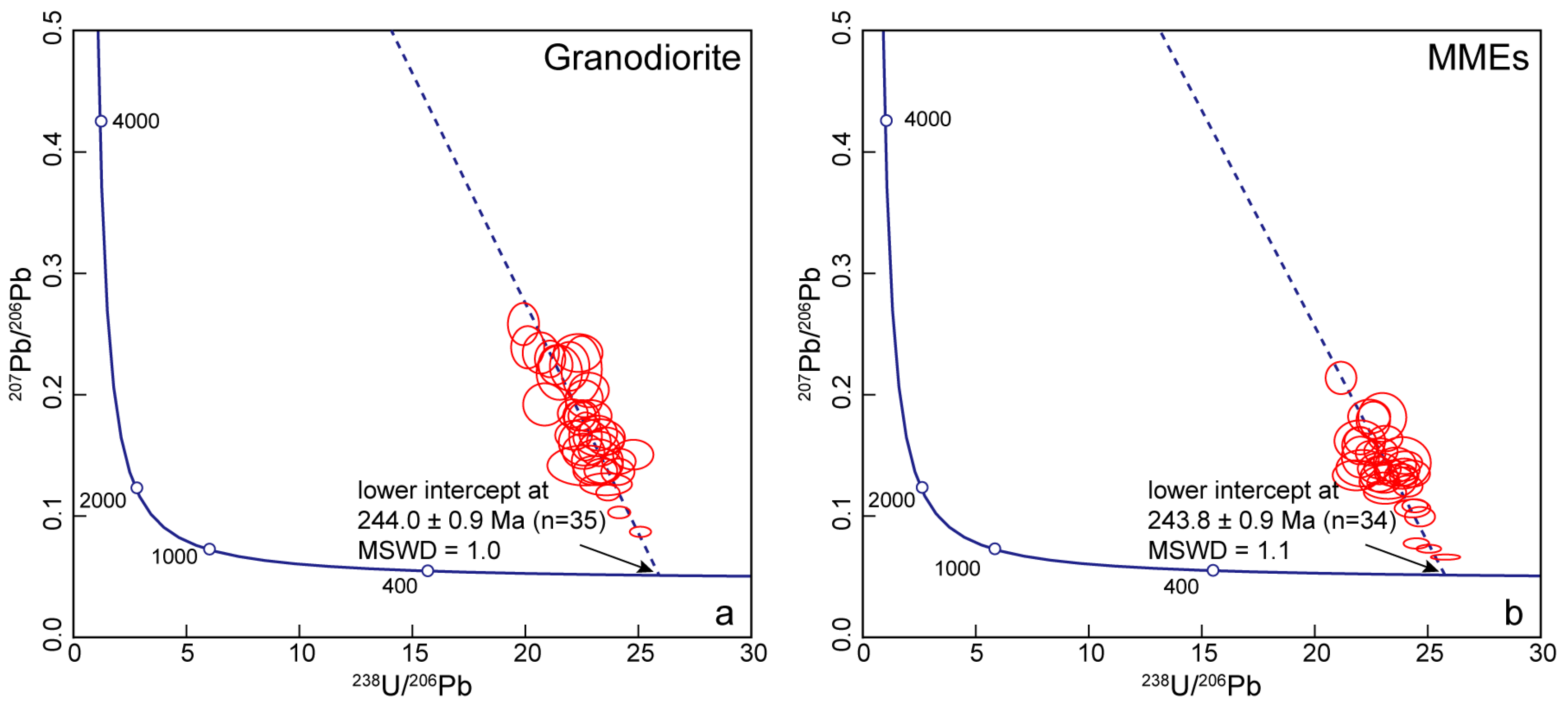

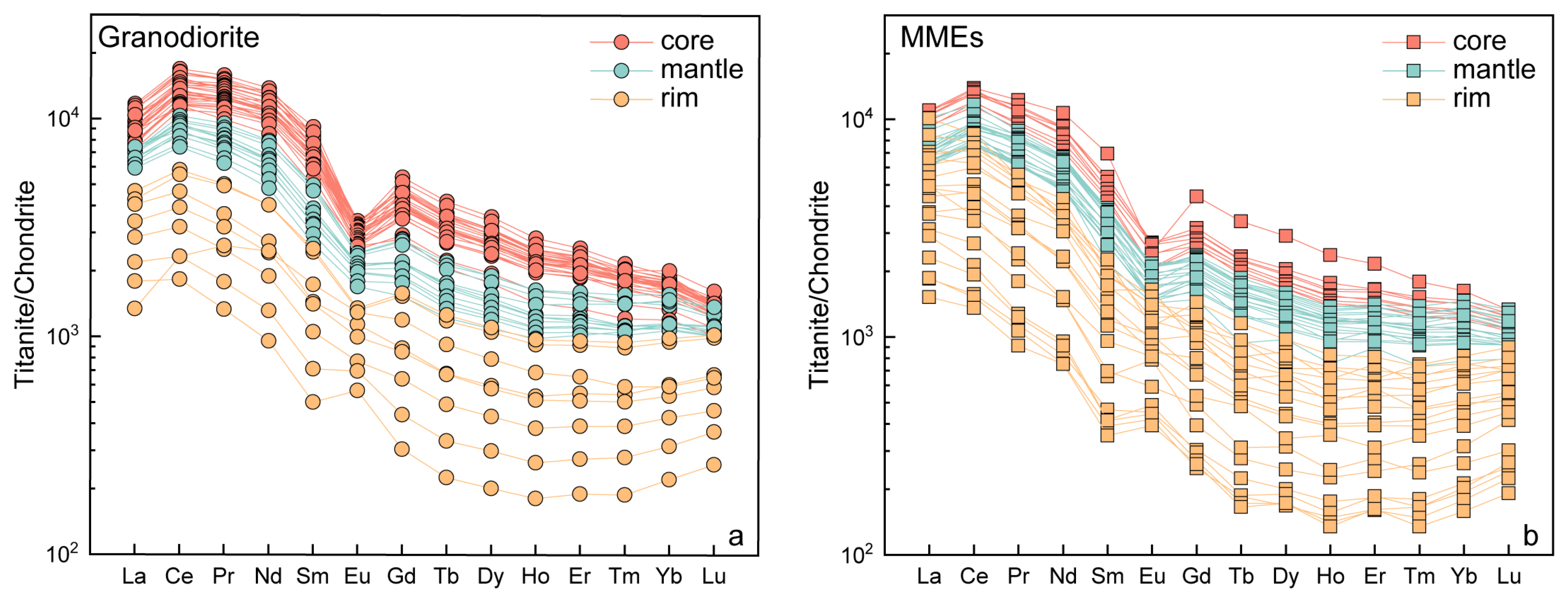

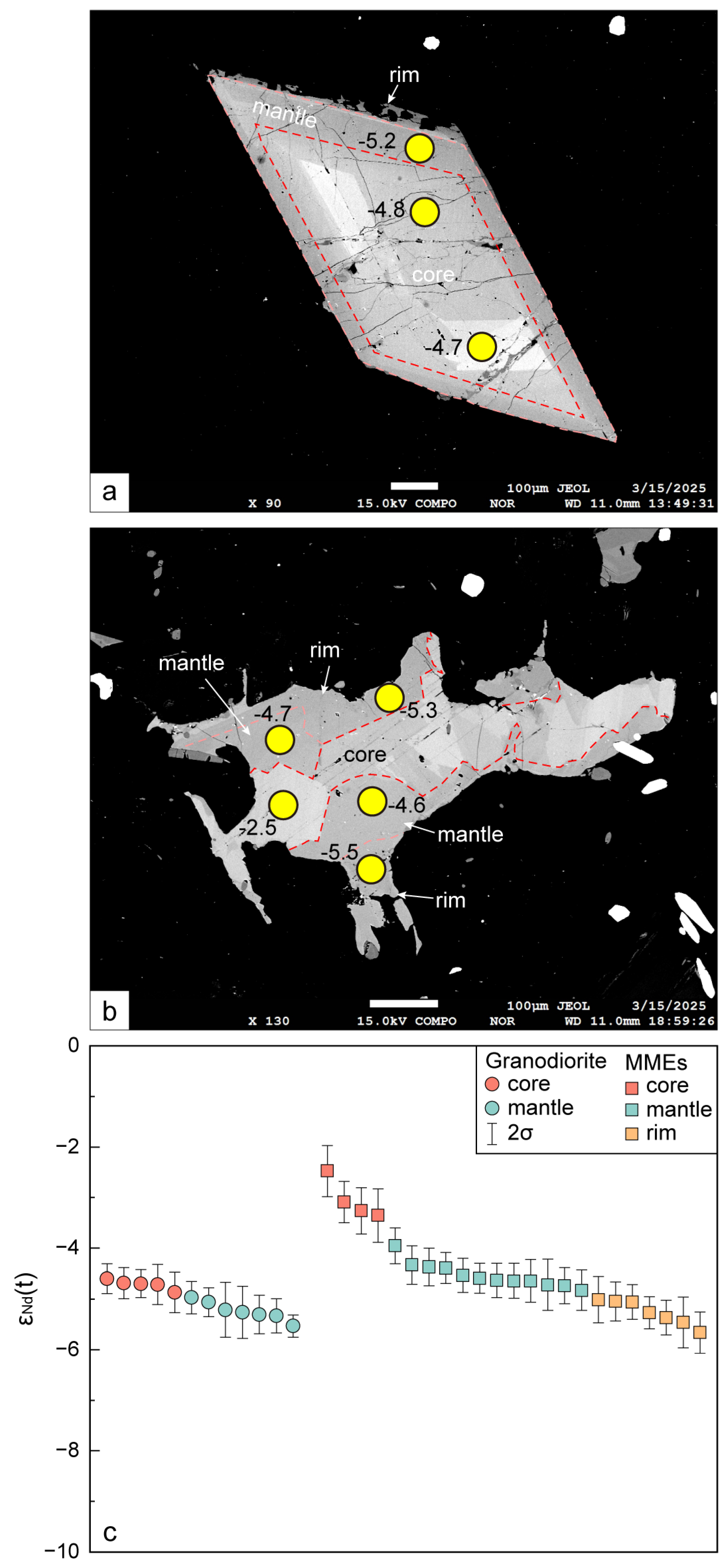

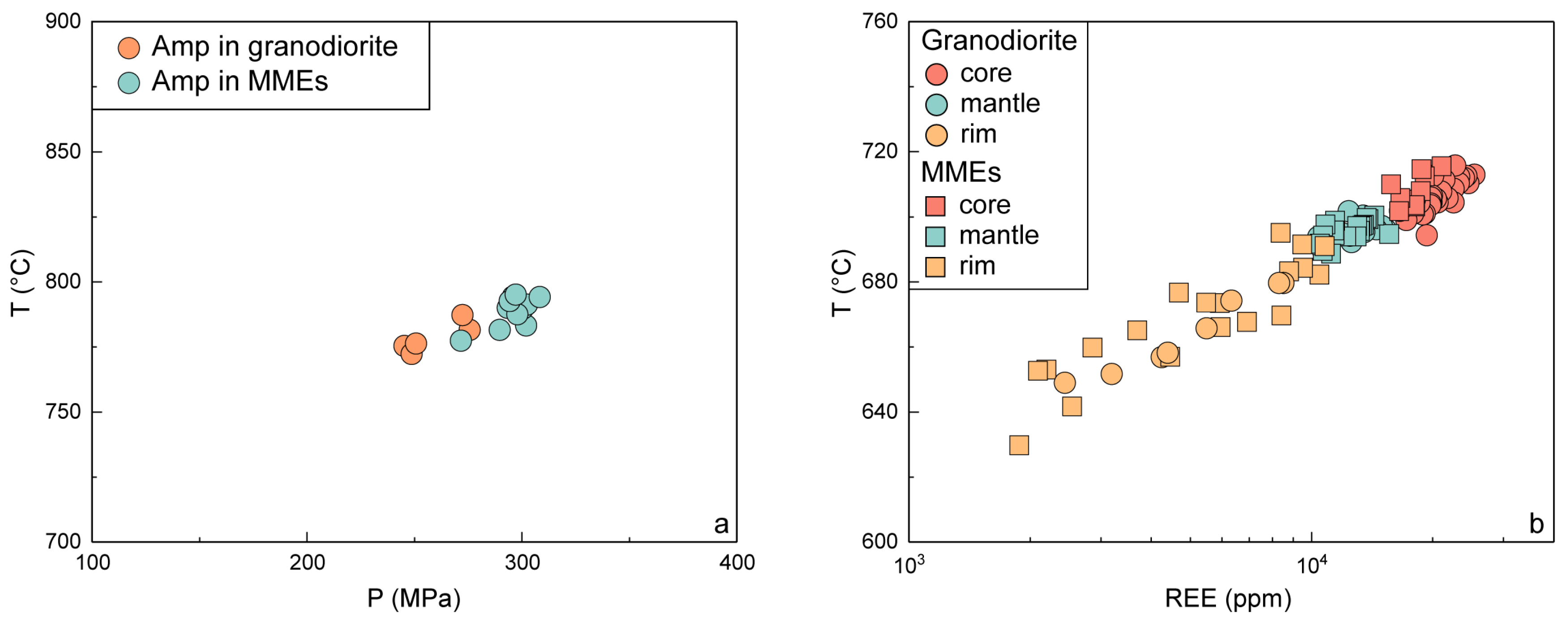
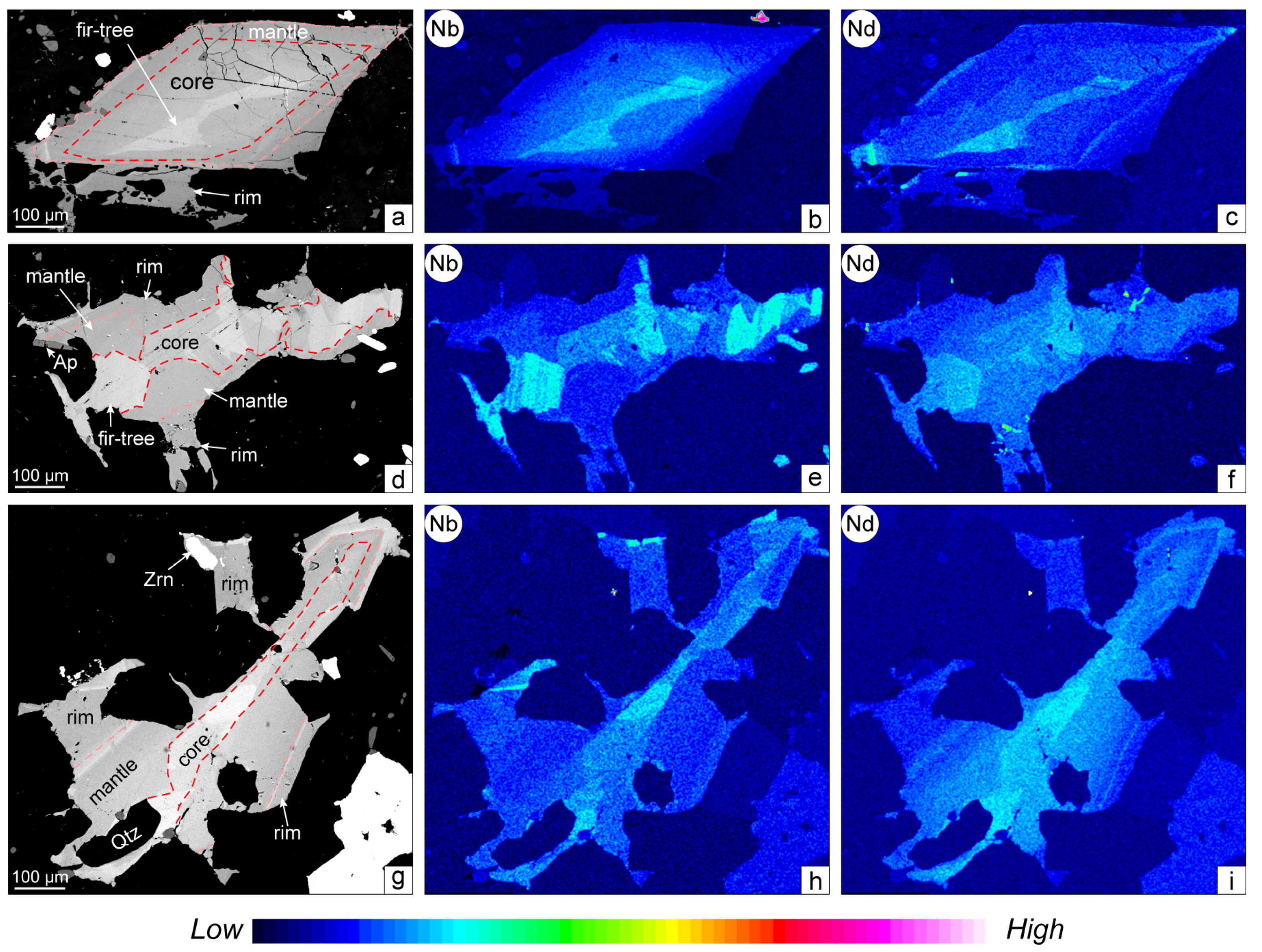
Disclaimer/Publisher’s Note: The statements, opinions and data contained in all publications are solely those of the individual author(s) and contributor(s) and not of MDPI and/or the editor(s). MDPI and/or the editor(s) disclaim responsibility for any injury to people or property resulting from any ideas, methods, instructions or products referred to in the content. |
© 2025 by the authors. Licensee MDPI, Basel, Switzerland. This article is an open access article distributed under the terms and conditions of the Creative Commons Attribution (CC BY) license (https://creativecommons.org/licenses/by/4.0/).
Share and Cite
Zhao, Z.; Wang, B.; Wu, S.; Li, J. Titanite Textures, U-Pb Dating, Chemistry, and In Situ Nd Isotopes of the Lalingzaohuo Mafic Magmatic Enclaves and Host Granodiorites in the East Kunlun Orogen Belt: Insights into Magma Mixing Processes. Minerals 2025, 15, 886. https://doi.org/10.3390/min15090886
Zhao Z, Wang B, Wu S, Li J. Titanite Textures, U-Pb Dating, Chemistry, and In Situ Nd Isotopes of the Lalingzaohuo Mafic Magmatic Enclaves and Host Granodiorites in the East Kunlun Orogen Belt: Insights into Magma Mixing Processes. Minerals. 2025; 15(9):886. https://doi.org/10.3390/min15090886
Chicago/Turabian StyleZhao, Zisong, Bingzhang Wang, Shengwei Wu, and Jiqing Li. 2025. "Titanite Textures, U-Pb Dating, Chemistry, and In Situ Nd Isotopes of the Lalingzaohuo Mafic Magmatic Enclaves and Host Granodiorites in the East Kunlun Orogen Belt: Insights into Magma Mixing Processes" Minerals 15, no. 9: 886. https://doi.org/10.3390/min15090886
APA StyleZhao, Z., Wang, B., Wu, S., & Li, J. (2025). Titanite Textures, U-Pb Dating, Chemistry, and In Situ Nd Isotopes of the Lalingzaohuo Mafic Magmatic Enclaves and Host Granodiorites in the East Kunlun Orogen Belt: Insights into Magma Mixing Processes. Minerals, 15(9), 886. https://doi.org/10.3390/min15090886



